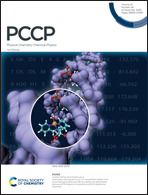Oxidation of isoprene by titanium oxide cluster cations in the gas phase†
Abstract
The heterogeneous oxidation of isoprene (C5H8) by metal-oxide particles, such as the typical mineral aerosols TiO2, plays an important role in the isoprene atmospheric chemistry. However, the underlying mechanism of C5H8 oxidation remains elusive owing to the complexities of aerosol surfaces and reaction channels. Herein, we report the gas-phase reactions of TixOy+ (x = 1–7, y = 1–14) cations with isoprene by using mass spectrometry and density functional theory (DFT) calculations. Five types of reaction channels were observed: association, hydrogen atom transfer (HAT), C–C bond cleavage, combined oxygen atom transfer (OAT) and HAT and combined OAT and C–C bond cleavage. It is noteworthy that formaldehyde is known as the major oxidation product of isoprene/hydroxyl radicals in the atmosphere. In addition, CO has not been observed in the reactions of isoprene with gas-phase ions. Therefore, the reaction mechanisms of CH2O and CO generation observed in Ti2O5+/C5H8 and Ti4O8+/C5H8 systems were further investigated by DFT calculations, and the calculated results are in agreement with the experimental observations. In these two reactions, both Ti and O atoms can be the adsorption sites for C5H8. The reaction channels and mechanistic information gained in these gas-phase model reactions may offer fundamental insights relevant to the corresponding oxidation processes over titanium oxide aerosols in the atmosphere.



 Please wait while we load your content...
Please wait while we load your content...